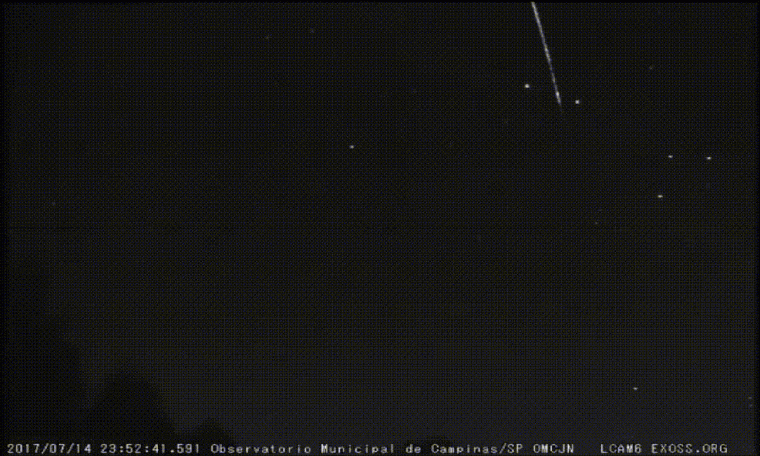
The month of May will end with a beautiful meteor shower that promises to delight astronomy lovers. According to the forecast, at dawn between this Monday (30) and Tuesday (31), a partial storm can be seen over Brazil.
As explained by Professor Rodolfo Longhi from the Didactic Observatory of Astronomy at the Universidad Estadual Paulista (UNESP) bauru (SP), the event will be better seen from North America, such as in Mexico or the United States, but it should produce a true light show in the skies of Brazil.
“The expectation is thousands of meteors per hour! If the predictions are confirmed, it will be a spectacle never seen in history, except on a similar record that happened in 1833”, the professor enthusiastically explained.
Meteor shower recorded in Rio Grande do Sul — Photo: Heller and Jung Observatory/Disclosure
A meteor storm is a shower of rock fragments from celestial bodies entering the Earth’s atmosphere. In this case, thousands of fragmented meteors per hour are entering the planet’s orbit.
As the professor explained, in 1995, there was a sudden increase in the brightness of the comet, which became about 600 times brighter than its average magnitude. It can also be seen with the naked eye, which was unexpected for a comet with a nucleus only 1.5 km in diameter.
A month after that “outbreak,” astronomers said the comet’s nucleus had broken up into somewhat larger pieces. Observations indicated at least four large fragments, two of which were in the process of disintegration.
The 1995 eruption threw a huge amount of dust into space. Some calculations suggest that on Tuesday night Earth will cross this debris-dense region vertically.
“Outbreaks are moments when the amount of meteors is about to increase. Imagine you’re driving a car on the highway and suddenly you drive through a swarm of bees, and they hit the window of your car. Earth. The same happens with the swarms of particles left behind by the comet”, oriented the professor.
Meteor shower in China — Photo: Reproduction/GloboNews
The trail of dust left by the comet annually generates a small meteor shower known as the Tau-Hercules.
This should provide at least two Tau-Herculidae outbreaks:
- Around 00:00 on Tuesday, the first “outbreak” should occur, when Earth will pass the debris trail left by comets in 1892 and 1941. For this “outbreak”, 50 meteors per hour are expected;
- The second outbreak should occur in the early hours of this Tuesday, at a time when Earth approaches the dense trail that began with its 1995 breakup. Since this will be the first time we will cross this mark, there is not much consensus about the exact time when it will happen. , But probably around 2:15, at the same time that we will cross the mark left by the 1979 comet pass. At this time, indicates the rate of the original modeling 600 to 700 meteors per hour, However, given that the comet broke apart in 1995, the intensity of this outbreak could reach ten thousand, or maybe 100 thousand meteors per hour during max,
“If the most optimistic estimates are confirmed, it will certainly become one of the largest meteor storms ever observed”, observes the professor.
The meteor shower associated with the extensive trail of debris left by the comet – Photo: Astropics.com, Wally Pacholka / AP
According to the professor, it is still not possible to ascertain the exact width of the debris mark. If it’s widespread, it’s possible that the Tau Herculides meteor will be visible from Monday night until 2:30 this Tuesday morning.
“It would be very worthwhile to seek a dark place away from the major centers and try to observe all the moments of this spectacular celestial event”, he concluded.
Engraving depicting the Great Meteor Storm of 1833 — Photo: Adolf Volmy/Handout
The most famous meteor storm in history occurred between November 12 and November 13, 1833, when an “outbreak” of the Leonidas meteor shower produced a spectacle in the sky of the United States.
According to the professor, the outbreak of Leonidas was completely unexpected, and therefore, caused a stir and frenzy in the population. Several incidents that night were recorded in the United States.
To explain everything in detail and thoroughly, the professor invites astronomy lovers to program at the Café Museum, which is located about 30 minutes from here. bauruFrom this Monday, at 19 pm.
On site, it will also be possible to observe the sky with the help of binoculars and enjoy a meal. Admission to the event, open to the public, is R$20 for the whole event and R$10 for a half. reservation must be made by Form,



